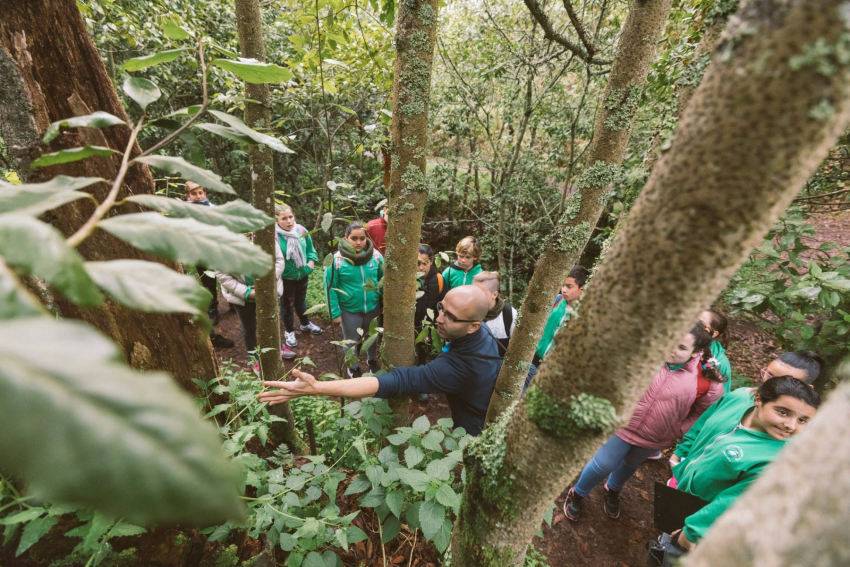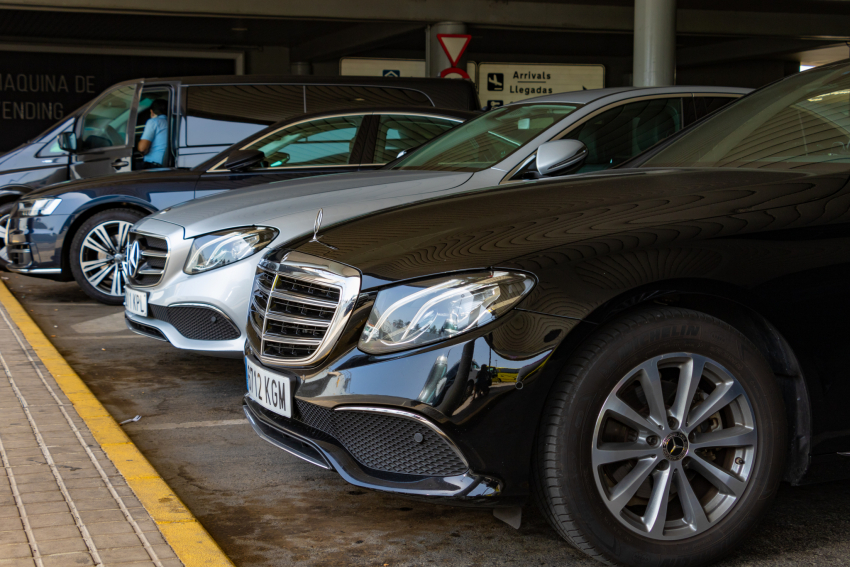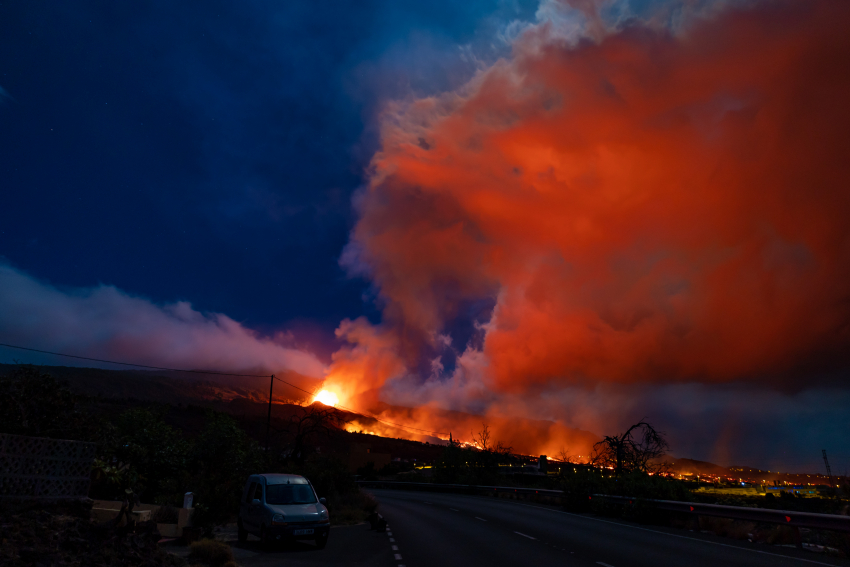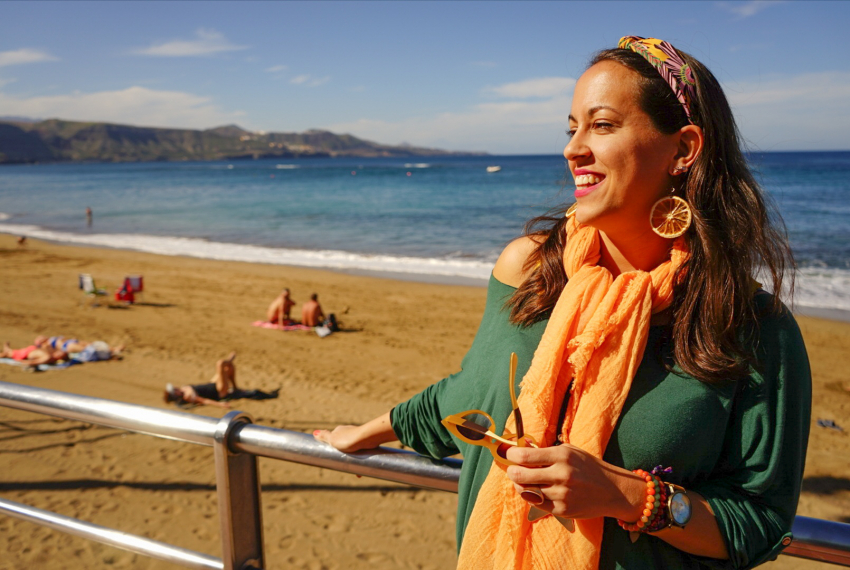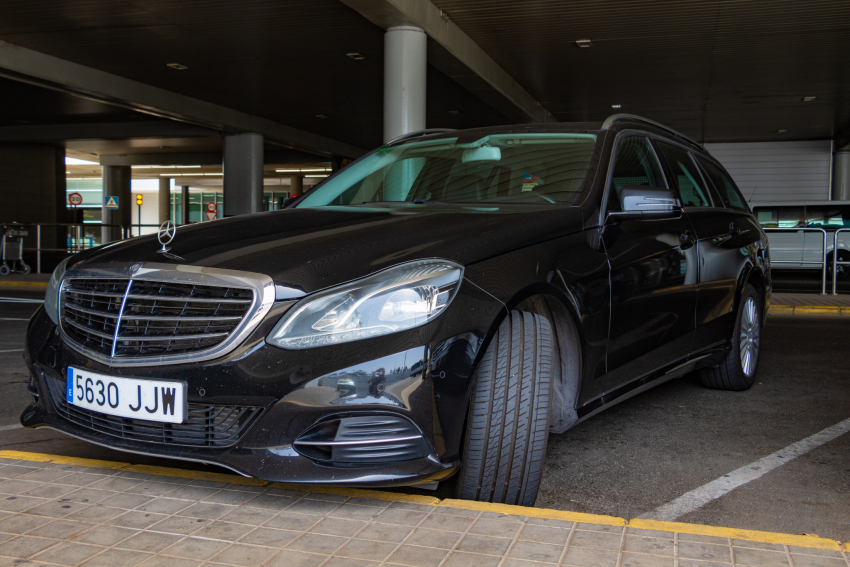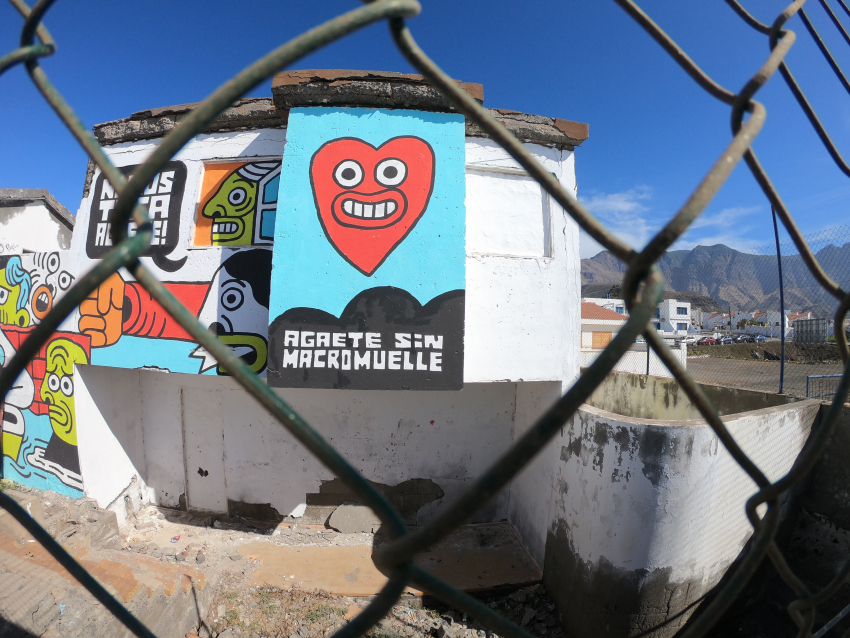Between March and the end of April the chunk of Gran Canaria between the Caldera de los Marteles and Tenteniguada, high up in the hills above Telde, goes technicolour.
This spring explosion of colour comes from a range of native species with purple, blue, yellow and red flowers. The most famous are the tajinastes or viper's bugloss flowers but buttercups, aeoniums, cinerarias, poppies and sonchus (giant dandelions ) all flower here at the same time.
Most of the tajinastes are blue, pink or purple but the challenge is to spot one of the rare red flowered plants.
You can walk a long loop from the Caldera de los Marteles down to Tenteniguada (about 6km) and back up again but the bulk flowers are within a kilometre of the road just past the clump of pine trees. There is no bus back up so you either walk or use the old two-car trick. Bring food and water as there is nothing up here once you start walking (there is a snack van by the mirador).
To reach the Caldera, put the Caldera de los Marteles viewpoint into Google Maps and drive up through Telde and Lomo Magullo. Some Bus 13s also stops here on route from Telde to Tenteniguada but not all. If you get the bus to Los Marteles, you can walk back down to Tenteniguada and get another bus back to Telde and then on to Las Palmas or the resorts. To be honest, it is quicker and easier to do this with a hire car.
The flowers are down the hill on the side of the road opposite the crater. Just walk down the wide path until your eyes hurt and you are right there amongst Gran Canaria's most spectacular spring display.
Gran Canaria drinks a lot of rum but hasn't managed to produce a quality premium spirit until recently. Thankfully, the island distillery has now responded to competition from a smaller rival and made a quality white rum that is eminently sippable and mixable.
Many rums, one main distillery
The big Arucas distillery, known as the Fabrica de Ron, owns the Arehucas brand and Ron de Telde in Gran Canaria, along with most other brands of Canary Islands rum both white and brown. Most are cheap and cheerful, made to be mixed with cola and plenty of ice (the lemon slice is optional). The brown colour of basic rums comes mainly from caramel rather than years in a barrel. Most of the raw meterials come from South Africa.
The big exception to the mass market is the Ron La Aldea brand which used to be based in La Aldea in west Gran Canaria. It moved to La Palma many years ago whern Gran Canaria stopped growing enough sugar cane to support it.
It has remained independent and still produces La Aldea Blanca, w white rum we regard as the best basic white rum in the Canary Islands. It also makes La Aldea Pura Caña, a premium white rum made with the alcohol from fermented cane juice rather than molasses or sugar. This is in the style of French Caribbean Rhum Agricole and Brazilian Cachaça rather than Spanish Caribean Ron or British Caribbean Rum. Cane juice rum has a harbal or grassy taste and a richer flavour profile.
La Aldea Pura Caña was the go-to rum for Canary Islands bartenders making decent rum cocktails with local white rum. Until now...
Ron Zafiro by Arehucas
Zafiro is a premium white rum made from fermented and distilled sugar cane juice from cane grown in Gran Canaria close to the Arucas distillery.
It is smooth, slightly sweet and herbal; tasty enough to be sipped on its own. It also makes for excellent Cuba Libres (cubatas) anad rum cocktails. You need less of it in a drink to taste the rum which helps you stay standing for longer at carnival.
Zafiro is the white rum that complements Arehucas' premium Family Selection of 12 and 18-year old golden rums. Gran Canaria Info will, in the name of research, be testing these as soon as possible and comparing them to the equivalent rums from La Aldea.
Ron Zafiro retails for 18 euros a bottle and is well worth the extra few euros on top of the price of a standard bottle of white Arehucas.
Hotels in Gran Canaria seem to be suffering from a naming crisis. Instead of solid, confident names like Claridge's or The Ritz, we get full sentences like the Santa Catalina, a Royal Hideaway Hotel 5*GL or the Hotel Puerto de Mogán THe Senses Collection.
It's like the marketing teams have so much to say that they forget about the power of a brand and try and crowbar the entire brochure, plus the hotels' corporate mission statement, into the name.
The Design Plus Bex Hotel, located in the towering building that was originally Spain's Banco Exterior (BEX) in Las Palmas, has quite a modest name in comparison to some (and no punctuation 2.0 abominations). I'm just going to call it The Bex; jaunty and catchy at the same time and no need to breathe half way through.
Another thing that is modest about the Bex is the price of its daily lunch menu. At under 13 euros you get a drink, two courses and coffee, or drink and one course for under nine euros. What isn't modest, and comes for free, is the rooftop location high above Santa Catalina Square with 360º view of Las Palmas city.
The food, which changes regularly, is excellent quality and well presented and the atmosphere at lunchtime is relaxed and friendly. No need for mismatched Gucci loafers and a pink chihuahua here although you might feel out of place in Havaianas and a vest.
The food at The Bex at lunchtime
We started with crafty lunchtime cañas because it was a sunny day (yes, you get them quite a lot in the north). Then the watercress soup and gazpacho to start. Both solid if not souper. For mains an excellent cod dish with caramelised potatoes and asparagus, and a decent chicken couscous (which is as good as couscous gets). We skipped the cake dessert (another five euros).
The views and the excellent value make the lunch menu at the Bex an excellent option for anyone visiting Las Palmas for work or play. Phone in advance to check availability or turn up early.
The Casa Romantica restaurant was an institution in the Agaete Valley for years before closing down in the 1990s. It's now reopened after an extensive refurbishment and with a brand new menu.
The food is a cut above the standard 'papas con mojo and ropa vieja' you get in most Gran Canaria country restaurants. It's right on the line between cookery and cuisine; accessible yet elevated. All dishes made with local produce, much of it from the Agaete Valley and Puerto de las Nieves harbour.
We visited on a Wednesday afternoon and chose to sit out on the front terrace because it was warm and sunny. However, the spacious indoor dining rooms, decoared with local art and plenty of plants, would have been just as pleasant. Next door is a museum dedicated to Gran Canaria rural life and its local produce.
The food at Casa Romántica
The welcome glass of Los Berrezales rosé from the bodega just up the road was a lovely welcoming touch. The green almogrote (a pesto of mature goat cheese, coriander and garlic) canapes delicious.
We ordered a light lunch of rabbit gyozas in gravy, onion soup made from local Galdar onions, and baked vegetables with slow-cooked bonito flakes. For dessert an orange and chocolate montage with lemon grass and basil.
Rabbit is a classic Gran Canaria country meat much appreciated by the locals (everybody loves free food). It's not the tastiest meat and is very lean. The rich gravy did the trick in this dish with each ravioli a little parcel of umaminess.
The onion soup, with a cured cheese parcel lurking at the bottom, was rich and tasty, and beautifully presented.
The baked vegetables, cooked slow and topped with big flakes of just-cooked bonito, were superb. The veggies (local tomato, aubergine and leek) jammy and full of flavour, their richness offset by the intense fishiness of the bonito.
The chocolate dessert, a deconstructed mousse with little blobs of citrus and basil jelly, worked well.
Based on what we ate, we'll be going back ASAP to work our way through the rest of the menu, and to try the tasting menu and paired local wines (40 euros per head with wine).
All in all, the Casa Romantica is a welcome return for the Agaete Valley and a recommended stop on a tour around the island. The surrounding are beautiful and the food is quality and made from the best local ingredients.
Alex Says: One of my earliest memories is at the Casa Romántica back in the 1980s. I was there with my mother to photograph their vervet monkeys, at the time probably the only monkeys in Gran Canaria. She got too close to the bars of the cage and one of the monkeys ripped out a big handful of her hair. The monkeys have gone and my mum's hair grew back in the end!
How to get to the Casa Romántica
Located three kilometres up the Valley from Agaete town, you can't really miss the Casa Romántica. It's on the left as you drive up, tucked into it's own little side valley. If you don't drive, a taxi from Agaete town costs a few euros (taxis next to the church).
See the Google Map location.
There is plenty of parking at Casa Romántica. Book if you plan to visit at lunchtime at the weekend.
You can come on holiday to Gran Canaria on holiday guilt-free by offsetting your carbon production, and contribute to making Gran Canaria green again. Here's our detailed guide to all the things Gran Canaria is already doing to reduce the environmental impact of tourism.
And here is the way to offset your carbon consumption in a way that makes Gran Canaria a greener and better place for everyone...
Foresta: The Gran Canaria reforestation charity
The Foresta Foundation plans to replant all of Gran Canaria's primeval forests in a sustainable and fire-safe way. In the 1980s there were only 6000 hectares (one hectare is just larger than a football field) of forest in the whole island. This has now risen to 20,000 hectares. However, the island originally has 154,000 hectares of forest stretching from palm forests by the sea up to mountain pine forests. So, there is plenty of room for more trees: Here's a detailed guide to Gran Canaria's forests.
Foresta plants mixed forests of native species making sure that the right trees go in the right places. This means the forests grow faster and also makes them more resistant to forest fires and droughts.
Alex Says: To offset the carbon footprint of your flight to and from Gran Canaria you can sponsor a tree via Foresta.
Foresta plants one native tree sapling per donation in an appropriate location and cares for it (rabbit-proof fencing, watering, etc) until it gets established. A mature tree can absorb enough carbon dioxide during its lifetime to offset the carbon generated by one person on a flight to Gran Canaria. Three trees would offset all the carbon generated by return flights and all the activities yoiu do during a holiday in Gran Canaria.
The growing trend towards environmentally friendly and Carbon neutral travel is a good thing for the planet but a problem for Gran Canaria and the Canary Islands.
Without tourism, it is hard to see how the Canary Islands will survive because the local economy is 40% dependent on the industry.
So, given that travel guilt and the move to low-carbon living is an existential threat, what are Gran Canaria and the Canary Islands doing to reduce or eliminate the carbon footprint of travel and holidays? And what more can they do in the future?
The big Gran Canaria water battery
 East Gran Canaria is a windy place and its windmills often generate more power than the island can use. When this happens they have to be switched off, thus wasting a huge amount of potential green energy.
East Gran Canaria is a windy place and its windmills often generate more power than the island can use. When this happens they have to be switched off, thus wasting a huge amount of potential green energy.
The solution is to use two of the island's big mountain reservoirs as a giant battery to store excess wind energy.
 The way it works is very simple: Excess power generated from windmills pumps recycled water up to the Presa de Chira reservoir. When extra energy is needed this water runs down through a rock tunnel and drives turbines to make electricity. The water is stored in the lower Presa de Soria. From here it can either be used to water farmland, or pumped back up the hill when there is an excess of wind energy.
The way it works is very simple: Excess power generated from windmills pumps recycled water up to the Presa de Chira reservoir. When extra energy is needed this water runs down through a rock tunnel and drives turbines to make electricity. The water is stored in the lower Presa de Soria. From here it can either be used to water farmland, or pumped back up the hill when there is an excess of wind energy.
It's a clever and green way to reduce the island's dependence on burning oil to make electricity.
 However, the project is not popular with some of the islands ecologists who say it will damage pristine areas of the island (there will be some pylons) disturb the locals (the tunnel and turbines need some blasting work) and will be a for-profit operation (a Spanish power company has the concession).
However, the project is not popular with some of the islands ecologists who say it will damage pristine areas of the island (there will be some pylons) disturb the locals (the tunnel and turbines need some blasting work) and will be a for-profit operation (a Spanish power company has the concession).
Another complaint is that alternatives to the water battery could be better. However, these rely on experimental new tech such as hydrogen generation that just isn't ready to go.
 In balance we at Gran Canaria Info believe that the Chirea Soria water battery is a good idea.
In balance we at Gran Canaria Info believe that the Chirea Soria water battery is a good idea.
It means that at least half the island's electricity will be wind-generated (and that's with the island's current turbines). With offshore wind and solar power added, it could allow the island to go completely green.
Green energy research in Gran Canaria
 As you drive north from the airport to Las Palmas you see a huge grey square floating in the sea. This is the PLOCAN marine research station dedicated to investigating new ways to generate wind and wave power in the ocean. The Canary Islands also have experimental offshore wind farms,solar energy plants and a whole range of other green energy projects. With the ocean, wind and sunshine of the Canary Islands, it is a matter of time before we become energy independent and no longer need to generate carbon to keep the lights on.
As you drive north from the airport to Las Palmas you see a huge grey square floating in the sea. This is the PLOCAN marine research station dedicated to investigating new ways to generate wind and wave power in the ocean. The Canary Islands also have experimental offshore wind farms,solar energy plants and a whole range of other green energy projects. With the ocean, wind and sunshine of the Canary Islands, it is a matter of time before we become energy independent and no longer need to generate carbon to keep the lights on.
A green levy or eco tax on tourists
 Tourism is an energy and resource-intensive business. Visitors want to reduce their carbon footprint but they also want fresh towels, green golf courses and air-conditioning. To compensate for the extra burden on the island's resources, politicians have suggested a small levy or tourist tax paid by every visitor. The funds would be invested, in things like reforestation, offshore reefs, low carbon transport and rewilding of abandoned farmland, to reduce the island's carbon footprint and counter the effects of tourism on the environment.
Tourism is an energy and resource-intensive business. Visitors want to reduce their carbon footprint but they also want fresh towels, green golf courses and air-conditioning. To compensate for the extra burden on the island's resources, politicians have suggested a small levy or tourist tax paid by every visitor. The funds would be invested, in things like reforestation, offshore reefs, low carbon transport and rewilding of abandoned farmland, to reduce the island's carbon footprint and counter the effects of tourism on the environment.
The benefit of this idea is that it would generate a large sum of money right away. The downsides are that it would be hard to collect, and some people would choose to go to other destinations that don't have a green levy. Another issue is how to decide who spends the money and on which projects. Politicians love coming up with ways to get more money but aren't always very good at spending it effectively.
Indirect taxes on visitor spend
 Instead of taxing every visitor, some think it would be better to add a green tax to certain things that damage the local environment or are cheap in the Canary Islands ton start with. For example, a surcharge on the price of petrol, or on luxury goods like perfume, premium alcohol and / or tobacco.
Instead of taxing every visitor, some think it would be better to add a green tax to certain things that damage the local environment or are cheap in the Canary Islands ton start with. For example, a surcharge on the price of petrol, or on luxury goods like perfume, premium alcohol and / or tobacco.
 Or, what if every hotel and large tourism business in the Canary Islands chose a carbon offset project and agreed to use a percentage of their profits to funding it. They could then show their guests and customers exactly what they were doing to reduce the environmental income of their holidays. For example sponsoring a specific rewilding or reforestation project, or contributing to an artificial offshore reef to increase marine biomass. Visitors would be able to watch a live fed of life on the reef that their hotel sponsors. Maybe on those silly giant iPads that every hotel reception has but nobody uses.
Or, what if every hotel and large tourism business in the Canary Islands chose a carbon offset project and agreed to use a percentage of their profits to funding it. They could then show their guests and customers exactly what they were doing to reduce the environmental income of their holidays. For example sponsoring a specific rewilding or reforestation project, or contributing to an artificial offshore reef to increase marine biomass. Visitors would be able to watch a live fed of life on the reef that their hotel sponsors. Maybe on those silly giant iPads that every hotel reception has but nobody uses.
Carbon Offset Schemes like reforestation and rewilding
 However it is paid for, rewilding and reforestation are going to be a major way that Gran Canaria offsets the carbon generated by visitors. The island now has 20,000 hectares of forest but once had over 150,000 hectares of pine, laurel, tree heath, wax myrtle and olive forests. Some of this is now occupied by towns, roads and farmland but there is a lot of space for replanting the forests.
However it is paid for, rewilding and reforestation are going to be a major way that Gran Canaria offsets the carbon generated by visitors. The island now has 20,000 hectares of forest but once had over 150,000 hectares of pine, laurel, tree heath, wax myrtle and olive forests. Some of this is now occupied by towns, roads and farmland but there is a lot of space for replanting the forests.
Other rewilding projects could include returning the abandoned farmland of the east and south coast to their natural state with native palm trees and vegetation.
See our detailed guide to the reforesting of Gran Canaria.
 Another important idea is to return Gran Canaria's natural water to the island's valleys. Gran Canaria is not a dry island but most of its water is currently piped from source to banana and tomato farms. It would be far more valuable flowing free to created natural firebreaks and new areas of natural beauty such as streams and waterfalls.
Another important idea is to return Gran Canaria's natural water to the island's valleys. Gran Canaria is not a dry island but most of its water is currently piped from source to banana and tomato farms. It would be far more valuable flowing free to created natural firebreaks and new areas of natural beauty such as streams and waterfalls.
Low carbon transport and travel
 For visitors to Gran Canaria, using public transport, taking care with water and electricity use and eating only sustainable meat (such as grass-fed Spanish or Uruguayan beef) are small but significant ways to reduce their carbon footprint. Here's a good list of ways to reduce the impact of your next holiday.
For visitors to Gran Canaria, using public transport, taking care with water and electricity use and eating only sustainable meat (such as grass-fed Spanish or Uruguayan beef) are small but significant ways to reduce their carbon footprint. Here's a good list of ways to reduce the impact of your next holiday.
Consuming local produce such as wine, cheese, fruits and vegetables also contributes to reducing emissions on imports and supporting rural life in Gran Canaria.
If you want to do more, then there is a local charity that does a superb job...
Foresta: The Gran Canaria reforestation charity
 The Foresta Foundation is dedicated to replanting all of Gran Canaria's primeval forests in a sustainable and fire-safe way. It plants mixed forests of native species making sure that the right trees go in the right places. This makes the forests grow faster and also makes them more resistant to forest fires and droughts.
The Foresta Foundation is dedicated to replanting all of Gran Canaria's primeval forests in a sustainable and fire-safe way. It plants mixed forests of native species making sure that the right trees go in the right places. This makes the forests grow faster and also makes them more resistant to forest fires and droughts.
 To offset the carbon footprint of your flight to and from Gran Canaria you can sponsor a tree via Foresta. It plants one native tree sapling per donation in an appropriate location and cares for it (rabbit-proof fencing, watering, etc) until it gets established. A mature tree can absorb 1000 kg of carbon dioxide during its lifetime, more than enough to offset the 650kg of carbon that each return flight to Gran Canaria generates per person.
To offset the carbon footprint of your flight to and from Gran Canaria you can sponsor a tree via Foresta. It plants one native tree sapling per donation in an appropriate location and cares for it (rabbit-proof fencing, watering, etc) until it gets established. A mature tree can absorb 1000 kg of carbon dioxide during its lifetime, more than enough to offset the 650kg of carbon that each return flight to Gran Canaria generates per person.
There are three main types of Gran Canaria airport transfer services, each with its own benefits, risks and price point. Here's our guide to them all, and a shameless plug for the in-house transfer service that helps keep the lights on at Gran Canaria Info's headquarters.
Man from pub with car
The cheapest airport transfer service is the 'man (or woman) from the pub with a car' service. This is operated by a Gran Canaria resident who picks people up in their own car from the airport. They often advertise in pubs or run pubs in resort areas, and get customers by word of mouth. They don't advertise online or in public because this type of service is 'under the radar'.
With the man with car model you are basically paying cash in hand for someone pretending to be your friend to pick you up from the airport (or drop you back). As such they will be parked in the public car park rather than in the public transport zone next to arrivals.
Legal transfer cars have blue license plates, a VTC aand SB sticker in the window, and their own parking zone at the airport. A legitimate driver does not have to pay a parking fee. Read more about the differences between legal and illegal transfers here.
This airport transfer service is often the cheapest option because the bloke with car does not have to pay for advertising and often doesn't pay business rates, taxes or professional insurance from their takings. They are cheap because they cut corners.
We don't really support this model of airport transfer service for two reasons. The first is that we don't know if a particular man with car is insured and / or a safe driver. The second is that we have no idea whether he pays anything back into the local Gran Canaria economy. We do know that informal transfers undermine the local drivers and companies who do pay their taxes and business fees.
Imagine the scandal in Puerto Rico if taxi drivers started selling tax-free beer to tourists!
The big branded airport transfer services
These are the services like Hoppa, Viva, Sun, etc.
These airport transfer services have large advertising budgets and websites that offer transfers from any airport. You book, pay upfront and when you walk through into arrivals, there is a driver with a sign waiting for you. The booking service takes a big chunk in commission and pays the rest to the company that owns the car and pays the driver.
Services like Hoppa and Viva never actually own the car or employ the driver that you meet. Nor do they have a help desk, or even employ any staff on the island. Instead they are based offshore and the savings they make mean that they caan spend huge amounts on advertising. Then they keep asking for lower prices from the drivers as they gain market share. None of the money they take in commission stays in Gran Canaria or any of the other destinations they offer.
There is very little difference between these services because they all use the same local companies to do the actual driving. A licensed local driver will reach the airport and pick up the next passenger on their list without even knowing which website they booked with. The driver is paid and the car insured by the local transport company that owns the cars, not by the booking service.
That said, all big branded services tend to be reasonably priced and are quite reliable. However, if something does go wrong there is nobody on the ground to sort it out. If a big transfer service drops the ball, then you are likely to be on your own, or at least face a long delay until someone at the call centre works out what happened.
Local Gran Canaria airport transfer services
 The transport companies that operate the cars and pay the drivers that do Gran Canaria airport transfers do take direct bookings. However they also work with local transfer services to handle international bookings. It is easier and just as economical for them to pay commission as it is to take bookings themselves.
The transport companies that operate the cars and pay the drivers that do Gran Canaria airport transfers do take direct bookings. However they also work with local transfer services to handle international bookings. It is easier and just as economical for them to pay commission as it is to take bookings themselves.
This is what we do at Gran Canaria Info. We work with exactly the same drivers and cars as all the branded transfer services. However, the commission we keep is much smaller than the wedge that big services pocket. The commission we earn for handling the booking helps us to keep improving Gran Canaria Info.
Gran Canaria Info's airport transfer service is reliable, fairly priced and is all operated from Gran Canaria. This means that if something does go wrong (delays, traffic, breakdowns) we are here to sort things out as quickly as possible.
What about buses and taxis at Gran Canaria airport?
The local Gran Canaria bus network is decent and you rarely have to wait more than half an hour before hopping on a bus to the main resorts or to Las Palmas. Just follow the bus stop signs at arrivals, then check Google maps for the next bus to your destination. Then take a taxi from the bus stop or station closest to your accommodation. For one person, or a couple, using the buses saves money but once there are three of you or more, a taxi or transfer often works out cheaper.
Taxis queue right outside the arrivals lounge at Gran Canaria airport. They are reasonably priced and you can normally just walk over and get one right away. However, there can be queues at peak times and prices rise late at night, on fiesta days and on Sundays. There is a limited supply of large taxis so if your group is bigger than four (three if the Covid Levels go up), then it is better to book a large vehicle with a local Gran Canaria transfer service. A transfer is always cheaper than using two taxis, and transfers are cheaper than the standard taxi meter rate for resorts like Mogán and Puerto Rico that are further from the airport.
So, there you have it. The facts about Gran Canaria airport transfers. Obviously we'd love you to use our own reliable service, or to book an excursion or boat trip with us but the decision, like the holiday, is all yours. Thank you for visiting Gran Canaria Info and we hope to see you in our Gran Canaria Info Facebook Group soon.
If you want to book the Gran Canaria Info airport transfer service, or a transfer back to the airport, you can do it here. Our service is reliable and well-priced and using it helps us keep the lights on at GCI headquarters.
Teide volcano was belching ash when Columbus sailed past on his way to accidentally discovering America in 1492, and a large chunk of Lanzarote got covered in lava during the 1730s. More recently, El Hierro experienced an undersea eruption off its southern tip in 2011 and La Palma island is currently experiencing an eruption on its southwestern flank.
Volcanic activity can be violent and destructive with houses and farms swallowed by lava and ash. However, volcanoes are also the reason the Canary Islands exist and without fresh lava, the archipelago will one day disappear back under the sea.
And since eruptions have been an inevitable part of live on the Canary Islands since people arrived here, the locals know how to take advantage of the lava once it cools. Here are some of the ways Canarians have made amazing things out of lava flows.
Natural swimming pools made from lava
 When molten rock hits the sea it forms a rock delta or fajana that sticks out into the sea. In many cases they form natural pools because the lava shrinks as it cools, or blocks off an area of the old coastline. The nartual pools at Agaete in Gran Canaria, called Las Salinas, are a great example of this. Pozo de las Calcosas pool in El Hierro is another. And La Fajana in La Palma is yet another.
When molten rock hits the sea it forms a rock delta or fajana that sticks out into the sea. In many cases they form natural pools because the lava shrinks as it cools, or blocks off an area of the old coastline. The nartual pools at Agaete in Gran Canaria, called Las Salinas, are a great example of this. Pozo de las Calcosas pool in El Hierro is another. And La Fajana in La Palma is yet another.
Lava Cemeteries In Gran Canaria
 Gran Canaria's aboriginal people, called the Canarii, buried their dead in side lava flows at burial sites like Maipez in the Agaete Valley. Nobody knows whether they did it as an offerring to the mountains that they considered sacred or whether it was just a convenient place to put their dead. Either way, they chosse the solid lava rivers of Gran Canaria as the place for their cemeteries.
Gran Canaria's aboriginal people, called the Canarii, buried their dead in side lava flows at burial sites like Maipez in the Agaete Valley. Nobody knows whether they did it as an offerring to the mountains that they considered sacred or whether it was just a convenient place to put their dead. Either way, they chosse the solid lava rivers of Gran Canaria as the place for their cemeteries.
Lava banana plantations in La Palma
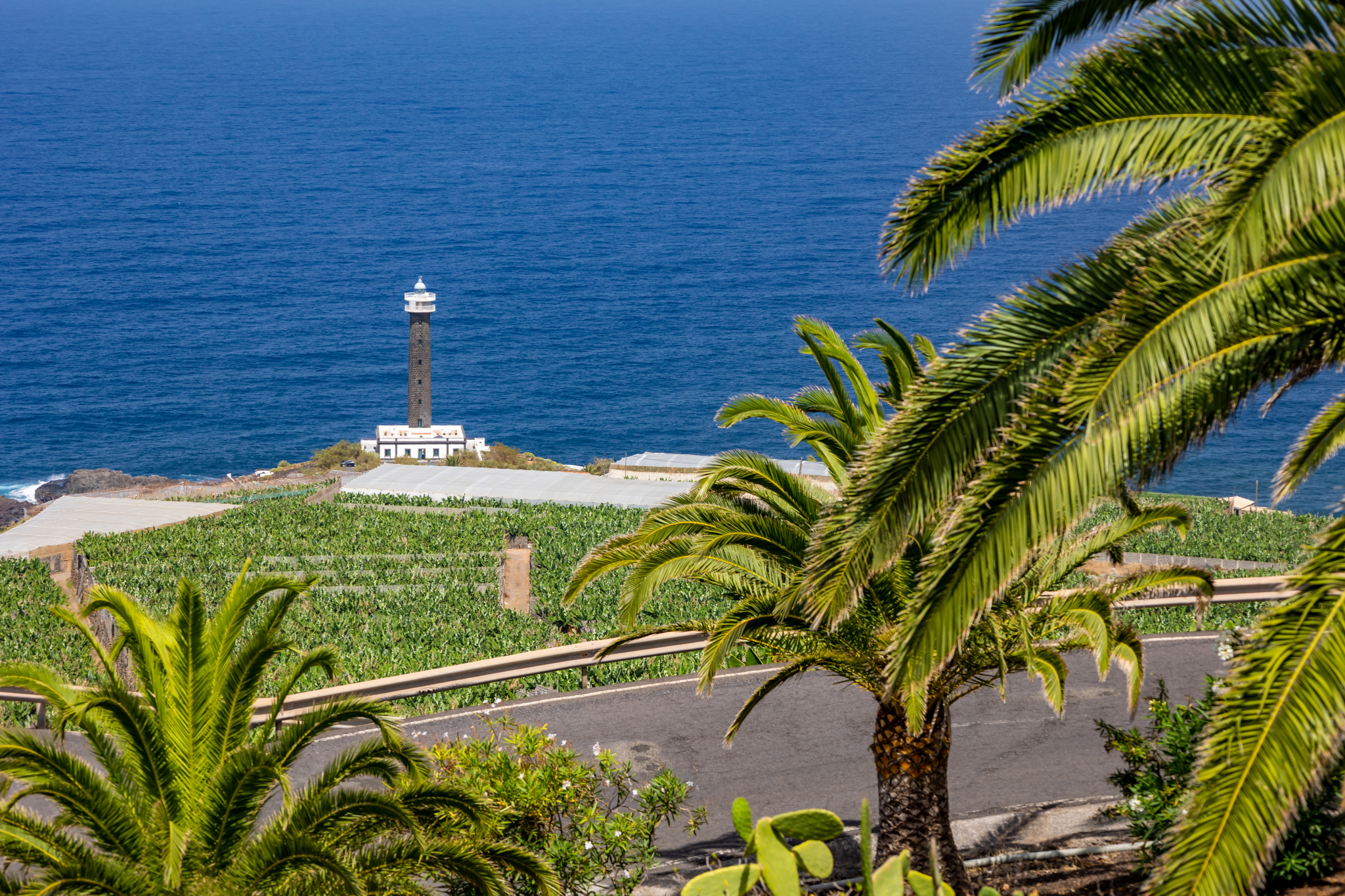 When La Palma erupted in 1949, the lave destroyed banana plantations as it flowed towards the sea. It then formed a large delta just to the south of the current volcanic activity. As soon as it was cool, La Palma locals started to bring soil from up in the highlands and put it on top of the lava. The area is now one of the most productive banana plantations in the Canary Islands. In Fuencaliente, at the far southern tip of La Palma, there is now a large, multicoloured saltpan on top of the lava from from the 1971 eruption.
When La Palma erupted in 1949, the lave destroyed banana plantations as it flowed towards the sea. It then formed a large delta just to the south of the current volcanic activity. As soon as it was cool, La Palma locals started to bring soil from up in the highlands and put it on top of the lava. The area is now one of the most productive banana plantations in the Canary Islands. In Fuencaliente, at the far southern tip of La Palma, there is now a large, multicoloured saltpan on top of the lava from from the 1971 eruption.
Auditoriums made out of lava tubes in Lanzarote
 As lava flows the surface cools and solidifies. The molten lava keeps flowing thjough within a rock tunnel. When the volcano stops it leaves behind long tunnels that were once underground rivers of lava. In Lanzarote, local artist Cesar Manrique took these lava tubes and made one into an Auditorium and garden at Los Jameos de Agua , another into a tourist attraction called the Cueva de los Verdes. He even built his house on top of a lava tube, put a swimming pool inside it, and had a lava flow inside his living room!
As lava flows the surface cools and solidifies. The molten lava keeps flowing thjough within a rock tunnel. When the volcano stops it leaves behind long tunnels that were once underground rivers of lava. In Lanzarote, local artist Cesar Manrique took these lava tubes and made one into an Auditorium and garden at Los Jameos de Agua , another into a tourist attraction called the Cueva de los Verdes. He even built his house on top of a lava tube, put a swimming pool inside it, and had a lava flow inside his living room!
Lava flows as walks and tourist attractions
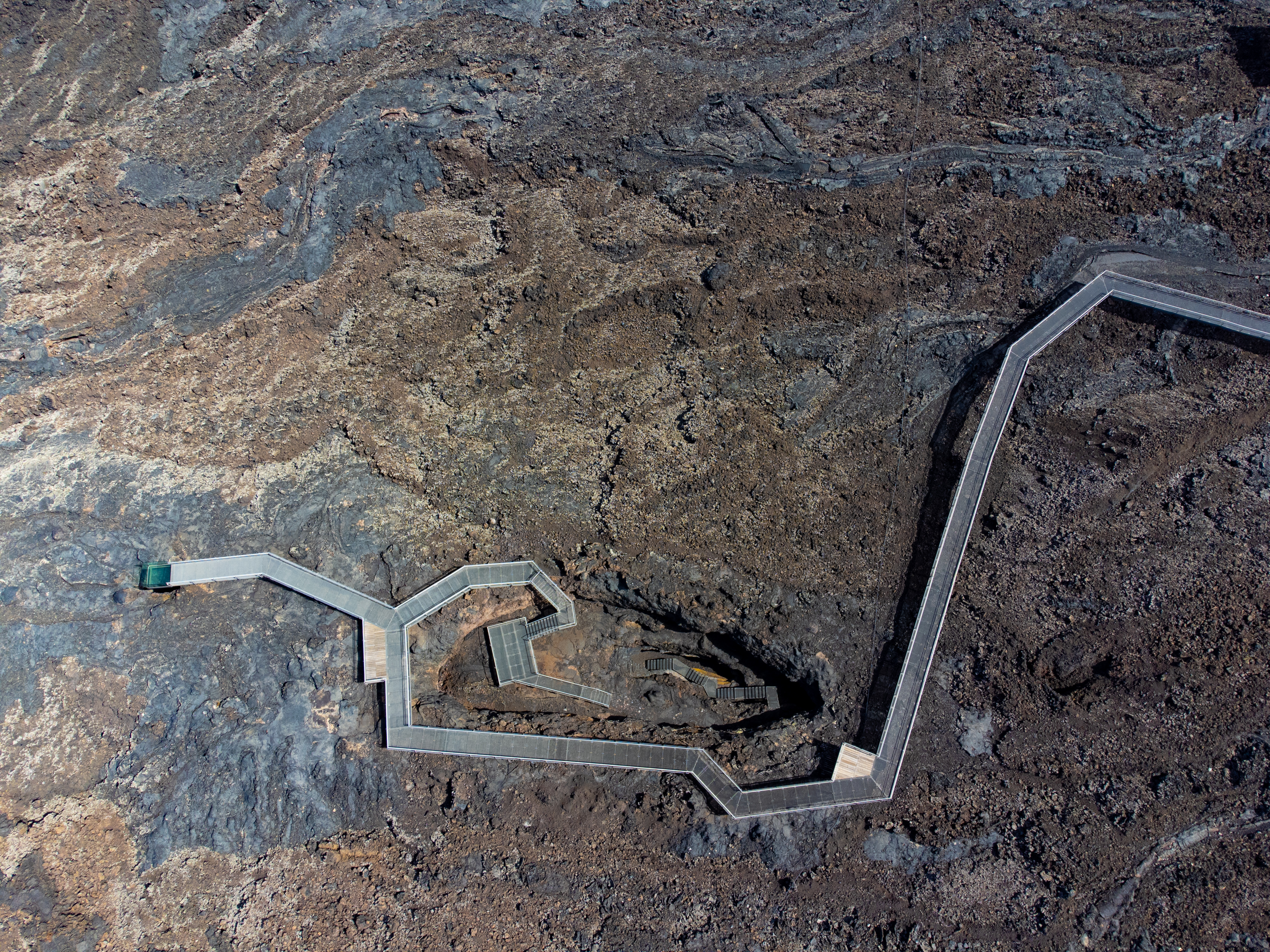 In La Palma, the Caños de Fuego visitor centre lets you walk over the lava flow from the 1949 eruption of the San Juan volcano, then drop down from the boardwalk into caves and tunnels left by the flowing lava as the volcano stopped.
In La Palma, the Caños de Fuego visitor centre lets you walk over the lava flow from the 1949 eruption of the San Juan volcano, then drop down from the boardwalk into caves and tunnels left by the flowing lava as the volcano stopped.
Barbeques using volcanic heat
 At Timanfaya in Lanzarote the ground is still so hot after the 1730 eruption that the restaurant cooks its food over an open pit. Around the back (ask the geyser man where it is) there are even a couple of barbeques that visitors to the Timanfaya National Park can use to grill their lunch.
At Timanfaya in Lanzarote the ground is still so hot after the 1730 eruption that the restaurant cooks its food over an open pit. Around the back (ask the geyser man where it is) there are even a couple of barbeques that visitors to the Timanfaya National Park can use to grill their lunch.
Vineyards on on the lava rock
 A thick layer of lava covered large areas of Lanzarote during the last eruptions on the island. Volcanic gravel, called lapili or picon, covered an ever bigger part of the island. This bubbly rock, formed from lava foam, traps moisture from the cool night air and keeps the soil buried metres underneath moist all-year-round. Lanzarote locals worked out almost as soon as the ground had cooled that they could dig down to the soil and grow crops and grape vines. Some of the vines they planted are still in their original holes almost 300 years later.
A thick layer of lava covered large areas of Lanzarote during the last eruptions on the island. Volcanic gravel, called lapili or picon, covered an ever bigger part of the island. This bubbly rock, formed from lava foam, traps moisture from the cool night air and keeps the soil buried metres underneath moist all-year-round. Lanzarote locals worked out almost as soon as the ground had cooled that they could dig down to the soil and grow crops and grape vines. Some of the vines they planted are still in their original holes almost 300 years later.
Thank you for booking an Airport Transfer with us!
Written by Lex ThoonenEverything worked as expected, and if your airport transfer is more than 24 hours away, then your airport transfer is now booked and confirmed!
When you get to the arrival gate the driver will be waiting for you holding this sign:

He or she will take you to your accommodation and you can pay that person the rest of the fee. Please make sure your phone is on and has roaming enabled.
While you're waiting to get to the island you (will) love so much, why not talk to our local experts about booking the perfect excursion or boat trip? We have a fastastic information service that works via Whatsapp and lets you find out exactly which excursion is best for you. You won't find the same excursions cheaper somewhere else, and by doing so you are supporting this website and everything we do on social media too. To talk to our Gran Canaria excursion team, just fill in this short Whatsapp form and we'll be in touch very soon.
Thank you very, very much for your business and see you soon on Gran Canaria!
Alex & Lex
Gran Canaria Info
Our Facebook page:
www.facebook.com/AboutGranCanaria
Our Facebook group:
www.facebook.com/groups/GranCanariaInfo
Our Youtube channel:
www.youtube.com/c/Gran-canaria-info
Learning Spanish for a couple of hours is a fun holiday option that lets you experience what it really feels like to be Canarian, and have some real-life interactions with locals during your stay in paradise.
It is also essential if you plan to stay on the island(s) or travel to Spain for more than a getaway.
In this article you will:
- learn about “La Casita de Laura - Learn Spanish”, a successful language business based in Las Palmas de Gran Canaria (teaching Spanish to foreigners for over 8 years!),
- pick up some useful Spanish tips for when you are in the Canaries and...
- get to meet the young entrepreneur behind it all.

HOLA, Laura León! Could you share a bit about why did you decide to dedicate your life to teaching Spanish and helping newcomers integrate in the local language and Canarian culture?
I love traveling and learning languages myself (I speak English, Italian, French and understand a few other European languages), so it soon became very natural to also share my language and my culture with other travelers. That is why almost 9 years ago I decided to create “La Casita de Laura – Learn Spanish”, to help newcomers integrate in the community and learn more about the locals, our way of living life and enjoying its simple things.

How easy is learning Spanish at La Casita? What can people expect when learning Spanish with you?
Imagine if you could learn Spanish with your best friend. Well, what we offer is exactly that! We are three freelance teachers working under the same brand name. What we do is we become our students friends and we guide them through the process of learning Spanish with a very conversational method and lots of practice. We keep it very simple and more importantly FUN, so our students don’t frustrated with all the boring grammar. Anyone joining our community can expect very little weekly commitment and a great progress. You just need to read our reviews and see how many students tend to extend their programs, to keep on learning and having fun with us.
So, you are teaching anyone who would like to learn Spanish? Do you only teach adults or also children?
We have had students from 5 up to 70 something years old. We do specialize in expat families and remote workers or digital nomads who need Spanish to live in the Canaries, but we also have many students who decide to come here on holidays and take Spanish to get to speak to locals and enjoy their experience to the max. I teach mainly adults but my colleague Niti is also really good with children. More recently, due to the COVID crisis we have focused more on the online teaching which has allowed us to get even students from abroad, people who would like to improve their Spanish and get ready for their next visit to a Spanish speaking city. For in-person lessons (whenever possible due to the restrictions), me and my colleague Niti we teach in Las Palmas and our other colleague, Dina, teaches in Maspalomas.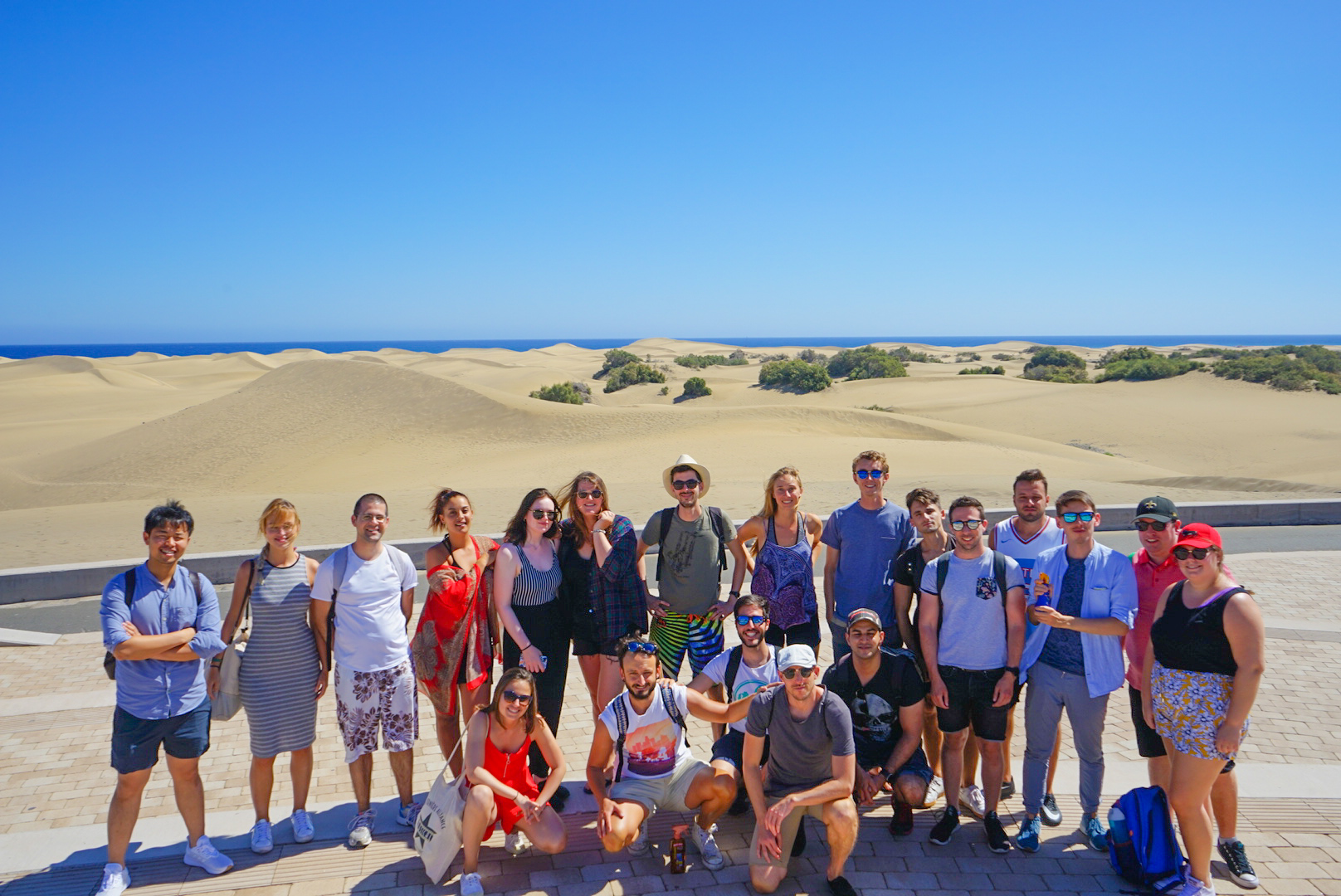
What would you say it is the common struggle of those who start learning Spanish?
They struggle with basic conversations in interactions with locals. They feel alone and lost in translation! Especially those who come to Gran Canaria to live with their Canarian partner - when they meet their new extended family they often feel like they can’t find the words to be able to interact in basic everyday life conversations. We focus on making that integration process faster and less painful. They find in our lessons a safe space for them to make mistakes (and not be judged), get proper corrections and grammar explanations when needed. It helps them regain some control in their lives. We connect with them because we understand what they are going through. It’s very rewarding seeing them grow confidence and become the most updated Spanish version of themselves. And they know they are not alone. We have created an amazing community and we do organize free Spanish meetups online and in-person ones whenever we can.
Could you share some Spanish tips for our readers to make it easier to understand Canarians?
Here you go, the top 5 Canarian Tips that will help you a lot:
1. Letter “-S” is kind of randomly exhaled mostly at the end of words, and it sounds almost like an English “h”, but for some reason tends to sound like an omission to foreign ears. One good example would be “gracias” which really sounds like “graseeah”, or ‘hasta luego’ which sounds like “ahta looegho”.
2. Canarians use “ustedes” instead of “vosotros” when addressing more than one person at the same time (“you all”). For example, we would say “¿Ustedes son de Reino Unido?” for ‘Are you all from the UK?’, instead of “¿Vosotros sois de Reino Unido?”. This actually happens also in most countries across Latin America, so we could say that “vosotros” is only used in the mainland, and even they may understand you if you use “ustedes” and not “vosotros”. Canarians can travel to the mainland and they never have any misunderstandings, they may just sound more formal – which is not a bad thing, right?
3. When Canarians use “mi niño/a” (my child), “mi cielo” (my sky), “mi amor” (my love) they are doing it from a good place as a term of endearment, don’t take it literally. They are not calling you “my child” or “my love”, they are just trying to be friendly and more approachable. Once you get used to it, you will miss it when you go back.
4. Canarians don’t use “Pasado Compuesto (Pretérito Perfecto Compuesto)”, they use “Indefinido (Pasado Simple)” instead. But I always encourage my students to use it because it’s easier to conjugate and we understand it anyway. For example, “Hoy fui a la playa” rather than “Hoy he ido a la playa”, to say that you went to the beach earlier that day.
5. We have a beautiful and very rich dialect and very funny words for some everyday things, for example “la guagua” for bus, “papa” for potato, “mojo” for our very own Canarian red or green spicy sauce, “millo” for corn, “leche y leche” for a delicious and extremely sweet coffee with condensed milk, “fleje” for when we want to say “a lot”, “calufa” for extreme heat and “chacho/a” for buddy/girl.
Thanks so much for sharing these useful tips and for your dedication to help newcomers in Gran Canaria. How can people connect with you?
They can find “La Casita de Laura – Learn Spanish” on Google, Facebook and Instagram, and also feel free to reach out via email to This email address is being protected from spambots. You need JavaScript enabled to view it. We are also working on our YouTube channel where we will be sharing tips and hacks to learn Spanish faster and easier.
So, if you would like to learn Spanish or improve it, head to “La Casita de Laura – Learn Spanish”; hands down the most fun and useful Spanish learning experience in Gran Canaria.
Gran Canaria Info recommends:
- Default
- Title
- Date
- Random





